 |
|

|
Seaweek
Discoveries in Victoria's Marine National
Parks
and Marine Sanctuaries (cont)
courtesy
Parks Victoria |
|
|
|
Butterfly
Perch
Caesioperca lepidoptera
A plucky and social fish, Butterfly
Perch form large, alluring schools
over deepwater reefs and ledges at
the Prom. They are opportunistic feeders
that take advantage of eddies that
swirl the microscopic animal life,
the zooplankton, into dense shoals.
The
areas of reef where this occurs are
usually covered with colourful sponges
and gorgonian corals, and, with the
combination of pink fish, it makes
a visual spectacle when diving. At
night, Butterfly Perch retreat into
rock crevices to sleep.
|
 |
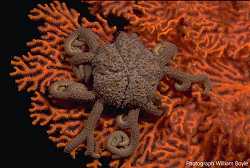
Gorgonian
coral and
basket star |
Gorgonian
coral
Mopsella zimmeri
Growing to nearly a metre in height
in some areas, the crazed branches
of the fan-shaped gorgonian corals
are a distinctive feature of the deeper
walls, caves and ledges of the Prom.
Orange, red or yellow in colour, gorgonians
are a colony of thousands of anemone
like polyps. These are retracted when
not trying to capture planktonic animals.
Gorgonian corals grow on an angle
to the prevailing surge and currents
to gain maximum exposure to passing
food.
You
might also see animals known as basket
stars with their arms intertwined
with the gorgonian's branches. At
nightbasket stars use the gorgonian
as a base for attachment while stretching
their long multi-branched arms into
the current to also catch plankton.
|
|
Weedy
Seadragon
Phyllopteryx taeniolatus
Despite its fierce name, the Weedy
Seadragon is a dainty, timid animal
that hovers slowly and gracefully
over the kelp forests where it shelters.
It grows up to 46 centimetres, with
long leaf-shaped flaps of skin that
project out at intervals along the
top and bottom of the fish enabling
it to camouflage easily amongst seaweed.
Seadragons
are related to pipefishes and seahorses,
and, like them, it is the male that
holds the eggs. With Weedy Seadragons,
the tiny pink eggs can be seen stuck
to the tail where they are brooded
for two months. They hatch as miniature
versions of the adults, but grow to
7 centimetres in three weeks. Weedy
Seadragons are only found in southern
Australian waters.
The
Weedy Seadragon is the marine state
emblem for Victoria.
|
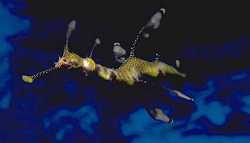 |
| |
|
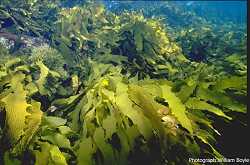 |
Leather
Kelp
Ecklonia radiata
Dense forests of Leather Kelp or Ecklonia
radiata, the deepest growing of
the large, brown seaweeds, blanket
the reefs around the Twelve Apostles
at depths between 5 and 25 metres.
Beneath its fronds the surge of the
waves and current is dampened, and
the forest provides shelter for numerous
fish species.
Ecklonia
forests are home to a myriad of tiny
species just as terrestrial forests
are home to an abundance of insects.
The dominant animals are tiny grazing
bug-like creatures known as amphipods
or sandhoppers and over 50,000 can
be found in a square metre. Of the
50 or so species that can be found
on a single Ecklonia plant, most feed
on a film of microscopic plants that
grow on the frond surface. Amphipods
are eaten by fishes such as wrasse.
|
| |
|
|
Red
Velvetfish
Gnathanacanthus goetzeei
While nestled deep amongst kelp fronds,
the Red Velvetfish is not easily seen
by divers. They are most active at
night, and if you are lucky enough
to come across one hunting for crabs
and octopus on the seafloor, its red
colouration is brilliant in the torchlight.
Without a torch or direct sunlight
the fish is relatively dull in colour
as red light is rapidly absorbed in
seawater. The red colouration makes
it appear dark assists camouflage
on deeper reefs.
Red
Velvetfish have a soft velvety skin
and scaleless bodies. This docile
fish protects itself with its venomus
spines. Growing to 46 centimetres,
the Red Velvetfish is only found in
southern Australian waters.
|
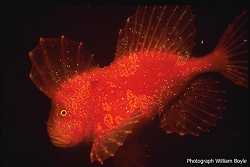 |
| |
|
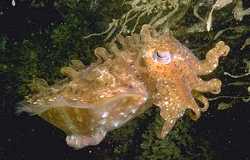 |
Giant
Cuttle
Sepia apama
The Giant Cuttle is the world's largest
species of cuttle and grows to nearly
1 metre in length. They feed on fish,
shrimp and crabs that they capture
with two long tentacles. Cuttles are
camouflage experts and are able to
change their body colours and textures
to blend in with their environment.
Like squid and octopus, they can squirt
ink to confuse predators that are
looking for a snack.
Cuttles
also contain an unusual shell that
helps them to float in the water -
these are often washed up on beaches
when the animal dies. Giant Cuttles
are found on rocky reefs in Southern
Australia's temperate waters.
|
|
|
|
|
|
